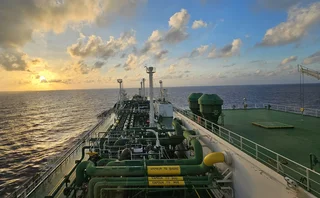CTRM software house of the year: Openlink
Energy Risk Awards 2018: Vendor facilitates first largescale CTRM public cloud deployment

During a volatile year in which IT budgets at many commodity firms remained pressured, Openlink continued to secure multi-million dollar deals for its core products as well as expanding into new geographies and markets and developing an entirely new cloud-based platform.
Openlink’s public cloud offering marks a milestone in the commodity trading and risk management space, by making largescale CTRM cloud deployment possible for the first time, says André Jäger, Openlink’s senior vice-president of product development.
“Up to now, public cloud offerings in the commodities space have addressed fairly standard systems requirements,” he notes. “Our offering changes the game by enabling large and complex trading, treasury and risk platforms to move to the public cloud with all the benefits that brings.”
The platform was developed in collaboration with Microsoft Azure and after engagement with dozens of clients. Openlink is now in the process of moving two clients – international energy firm Uniper, and a large Japanese utility – onto the platform.
Openlink carried out a three-month proof of concept project with Uniper between October 2016 and January 2017 in order to demonstrate that the system could provide the functionality, security and computing power the firm required, while also maintaining access to historical data.
“We carried out extensive testing with the client so that it could properly analyse the costs and performance of public cloud compared to on-premise solutions,” says Jäger.
For Uniper the project showed that a cloud-based delivery could significantly improve performance. For example, it considerably reduced the time taken by end-of-day batch processing, and it also supported intraday calculations that would not have been possible on premise. By enabling Uniper to scale up computing power but only pay for what it needed, the solution was also shown to lower the total cost of ownership, says Jäger. Uniper’s deal was for 700 users and covers front-to-back office trading and risk-management support across several asset classes including oil, gas, liquefied natural gas and power.
Our offering changes the game by enabling large and complex trading, treasury and risk platforms to move to the public cloud with all the benefits that brings
André Jäger, Openlink
Openlink’s second public cloud client, the Japanese utility, was considering cloud for its newly formed trading subsidiary that had been set up in response to gas and power market liberalisation in Japan. It opted for a cloud-based model for the scalability it offers a growing business, says Jäger.
“The firm wanted a solution that would grow as the business grew, for example being able to handle increased volumes, a move into new markets, greater numbers of users and the use of more sophisticated products such as options, storage contracts or long-term delivery contracts,” Jäger says.
As well as new product development, Openlink also had major success over the last year with its core Rightangle and Endur products, the firm says.
“What we’re seeing now is companies across the industry looking for ways to save costs and increase efficiencies,” Jäger says. “Many are now turning to us to extend their Openlink footprint so as to streamline the complexity of their existing IT landscape and to … increase [automation and] efficiency. The breadth we can offer as an end-to-end solution can help firms that want to have fewer different IT solutions in place.”
Openlink saw off major competition to sign various multi-million dollar deals for Rightangle in the liquid hydrocarbon markets. One deal included significantly increasing the number of users at a large refiner and another was with a retail gasoline company, both of which had signed up for Rightangle in 2015. The refiner selected the application for its logistics and tax capabilities. Rightangle can calculate tax on refined products in all 50 US states. “This is a major challenge for refiners and Rightangle simplifies it significantly,” comments Jäger.
There were also multi-million dollar deals for Endur, including an extension of users for the North American gas and power trading business of an oil major and a multinational energy firm signing up as a new client for its entire North American trading activity.
Openlink also further increased its presence in the agricultural space. A large US food company chose Endur to manage its end-to-end commodity activity, while a Singapore-based agricultural company signed a major deal to cover its full end-to-end supply chain with Endur from sourcing, operational executing, marketing, hedging, risk management, reporting and back office.
Clients have also turned to Openlink’s enhanced risk analytics offering over the last year. For example, a US-based natural gas liquids marketer expanded its use of Openlink’s Rightangle by using the new Risk Analytics Service. This provides integrated and automated risk calculation and reporting capabilities within Rightangle. Due to increased market activity, the firm needed to automate several intraday and end-of-day tasks and quickly view portfolio risk, in order to make well-informed, timely decisions.
An executive at the firm said his team has moved from spending 95% of its time collecting and capturing information to spending most of its time analysing information.
Openlink holds regular client events in order to understand and anticipate the needs of market participants. In its 2017 global summit, for example, it collaborated with more than 60 participants to evaluate the potential of blockchain technology in the CTRM space.
It is through this frequent customer interaction across a wide span of clients that Openlink hopes to remain ahead of the curve in the delivery of software applications and services in the years to come.
More on Risk management
CRO interview: Shawnie McBride
NRG’s chief risk officer Shawnie McBride discusses the challenges of increasingly interconnected risks, fostering a risk culture and her most useful working habits
Increasingly interconnected risks require unified risk management
Operational risk is on the rise according to a Moody's survey, making unified risk management vital, say Sapna Amlani and Stephen Golliker
Energy Risk Europe Leaders’ Network: geopolitical risk
Energy Risk’s European Leaders’ Network had its first meeting in November to discuss the risks posed to energy firms by recent geopolitical developments
Energy Risk US Leaders’ Network: tackling volatility
Energy Risk’s inaugural US Leaders’ Network convened in Houston in October to discuss risk management challenges caused by geopolitical upheaval, policy uncertainty and volatility
LNG trading strategies set to change amid major market shifts
The global LNG market is on the brink of significant changes set to alter trading dynamics and market behaviour, say analysts
Why commodity finance is ripe for stablecoin
Digital currency brings cost efficiencies to financing, but its real benefit to commodity firms lies in making huge pools of new capital available, write Jean-Marc Bonnefous and Ronan Julien
US shutdown leaves commodity traders without key data
Commodity traders are ‘flying blind’ without Commitment of Traders reports
Energy Risk at 30: Learning from the past
Energy Risk looks back at the seminal events and developments that have shaped today’s energy markets








